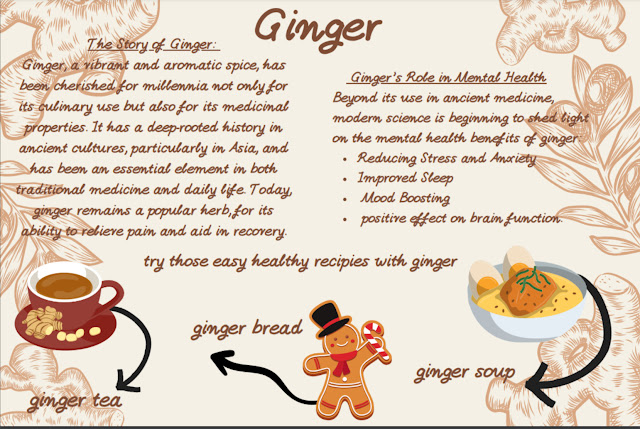Here is Alexia’s (B1) view of ginger in a beautiful poster:
Herbs and Spices
We all have experienced how different kinds of herbs or spices affect, not only our food but also our mood. That is not just a coincidence. Many of this “Natures wonders” are unexpectedly very beneficial for us. However, not many people know about all the benefits that some herbs and spices have to offer. We wanted to make our schools students to learn about herbs and spices, and share their new knowledge with their pupils. That is the reason why we collected 4 articles and posters from some of our students, about their favourite spice or herb.
The first article is Fay's (B1) approach to Lavender:
HERBS: LAVENDER PROPERTIES & BENEFITS (Fay B1)
Lavender is an herb with a lot of properties and benefits. It is often used in nutrition as a flavoring ingredient or as a fragrance ingredient in soaps, cosmetics, perfumes etc. Lavender is also known for its usage in pharmaceutical products and its unique contribution in the reduction of stress and anxiety, providing support to people who struggle with such issues.
BENEFITS OF LAVENDER:
• Reduces anxiety & depression
There are a number of methods of using lavender to soothe anxiety and stress. By forming topical application, lavender can soothe the body and mind by relieving anxious thoughts and balancing the mood. Apart from this topical application, you can also brew lavender tea and achieve much the same effect. The antioxidant components in it can impact the endocrine system to lower the levels of stress hormones in the body.
• Deals with sleep issues:
Lavender if it is used properly, it can help in dealing with sleep issues. By brewing a few lavender flowers in hot water, you can steep a wonderful tea that has been used to induce sleep and relaxation for thousands of years. This is closely linked to the flower’s impact on the nervous system, and can also help clear your mind of negative thoughts. As a result you are able to sleep easier.
• Skin care:
An easy way to always care for your skin is to fill a spray bottle with lavender flowers, so when you feel your skin is dry or irritated, you can simply use this method in order to glow your skin enjoy the quick relief.
• Protection of heart health:
Lavender helps in protecting your heart, as with the relaxation it ensures, it can reduce blood pressure and the tension of blood vessels and prevent you from unpleasant cardiovascular problems.
Lavender is a multipurpose plant. People use lavender in many ways to promote good health and well-being, including:
• dried flowers
• essential oil
• topical oil
• capsules
• teas, tisanes, and infusions
• creams, lotions, and salves
• beauty products
• Lavender flower
Another well-made article by Isidoros (B1 which happens to be myself):
Curry Leaves; a powerful herb
Curry leaves, scientifically known as Murraya koenigii, are aromatic herbs integral to South Asian culinary traditions, particularly in India and Sri Lanka. Often referred to as "kadi patta," these glossy, deep green leaves are harvested from the curry tree, a small, bushy plant native to the region. Their distinct, pungent fragrance and slightly citrusy flavor have made them a staple ingredient, setting them apart from the unrelated spice blend, curry powder.
In culinary applications, curry leaves are primarily used during the tempering process. This involves heating oil or ghee and then adding the leaves, along with pother spices like mustard seeds and cumin. The heat releases the leaves' volatile oils, infusing the cooking medium with their characteristic aroma. They are frequently incorporated into curries, lentil dishes, rice preparations, and savory snacks. Beyond tempering, they can also be added whole to soups and stews, or finely chopped and sprinkled as a garnish for a final burst of flavor.
The significance of curry leaves extends beyond the kitchen, deeply rooted in traditional Ayurvedic medicine. They are recognized for their rich antioxidant content and various bioactive compounds, including alkaloids, flavonoids, and phenolic compounds. These constituents are believed to contribute to a range of health benefits, such as aiding digestion by stimulating digestive enzymes, promoting healthy hair growth by strengthening hair follicles, and supporting skin health through their antimicrobial and anti-inflammatory properties. Furthermore, they are traditionally used to help manage blood sugar levels and cholesterol.
Nutritionally, curry leaves are a valuable source of vitamins and minerals. They provide vitamins A, B, and C, crucial for maintaining healthy vision, energy production, and immune function. They also contain minerals like iron, essential for red blood cell formation, and calcium, vital for bone health. This nutritional profile, combined with their potent phytochemicals, makes them a wholesome addition to a balanced diet.
Whether used fresh, dried, or in powdered form, curry leaves offer a versatile and flavorful way to enhance both culinary creations and traditional wellness practices. Their unique aroma, distinct flavor, and potential health benefits underscore their importance in South Asian culture and beyond.
Lastly, we have Elpida's (B1) gorgeous poster about oregano:
Editing by Isidoros Kladias


Comments
Post a Comment